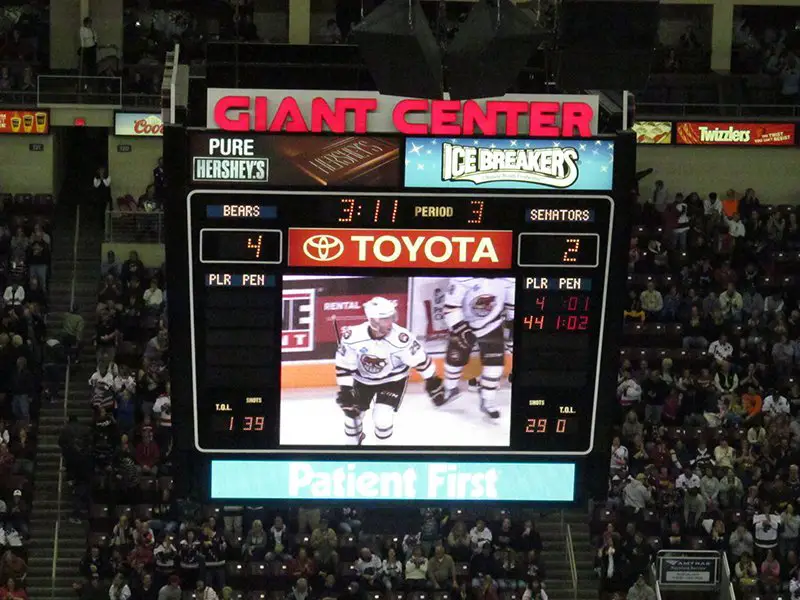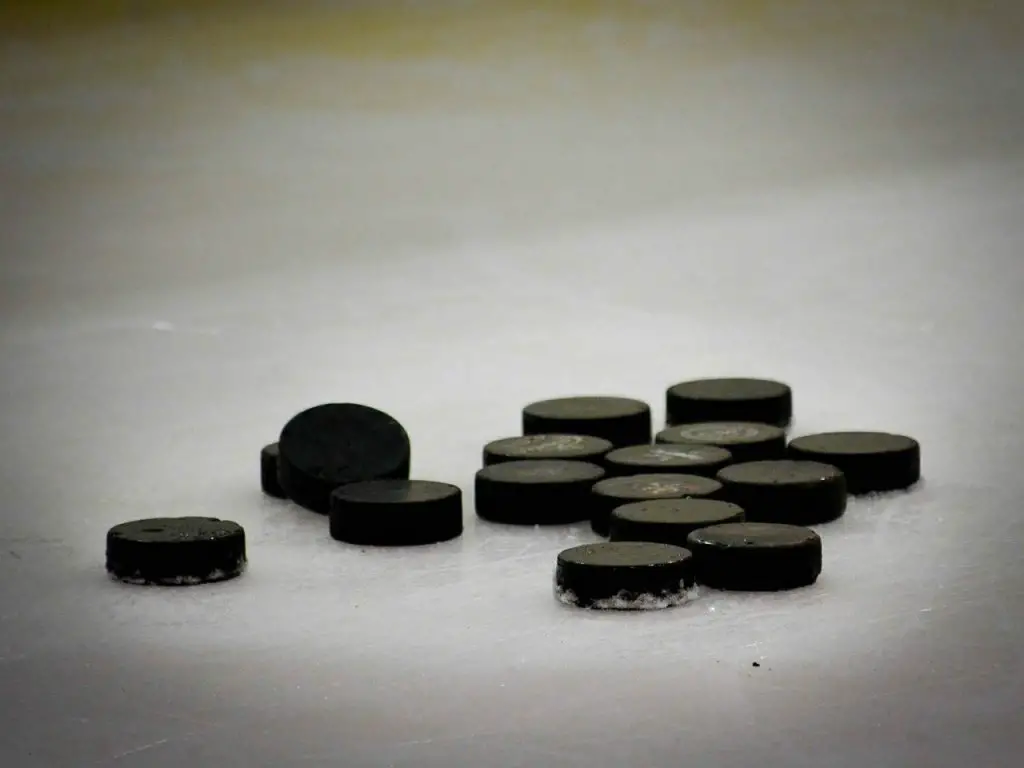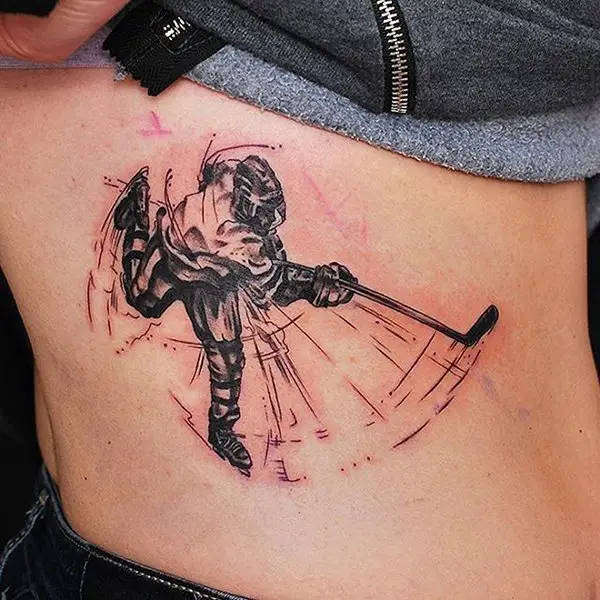Hockey is such an exciting and immersive sport. I’ve never had more fun than I have cheering on my beloved Maple Leafs (don’t judge me, being a Leafs fan is painful enough) in person with other lively and excited fans.
I’ve met some lifelong friends at games and couldn’t recommend the experience enough.
So, planning on heading to your first game and are unsure about how long full length ice hockey games actually lasts?
Let’s take a look.
Table of Contents
How long is a game of ice hockey?
Full length ice hockey games have three 20 minute periods equalling 60 minutes of regulation time and take 94 minutes on average to finish.
Between periods of a hockey game, there is a 17-minute intermission. This is why a full length game of hockey takes 94 minutes from the start to finish, despite actual game time only being 60 minutes.
Intermission times can vary depending on the level of hockey. Professional leagues tend to have longer intermissions between periods than a minor league.
What happens during the intermission?
Hockey players head back to their locker room to rest, usually there are snacks like orange slices and fruit for players to indulge themselves with.
Coaches talk strategy and tactics, sometimes switching the style of game they are playing, and officials make sure everything is ready for play again.
The crowd gets up and leaves to go to the bathroom and get beer, snacks etc.
How long do hockey games last on tv?
To watch a full NHL hockey game on television it will take on average 127 minutes, or, 2 hours and 10 minutes.
If you’re watching an NHL game at home, you would need to factor in the time commercial breaks eat up. Television timeouts are typically 2 minutes long and happen 3 times a period. So, during a full length NHL game broadcast, there are 18 minutes worth of television timeouts for advertisements.
Next, you will need to factor in stoppages in play which include icings, offside calls, penalties, injuries, and ice issues. When combined, this equates to about 15 minutes of stoppage time per game.
Period | Period Length | TV Timeouts | Play Stoppage | Intermission | |
1 | 20 minutes | 6 minutes | 5 minutes | 17 minutes | |
2 | 20 minutes | 6 minutes | 5 minutes | 17 minutes | |
3 | 20 minutes | 6 minutes | 5 minutes | None | |
Totals | 60 minutes | 18 minutes | 15 minutes | 34 minutes | 127 Minutes |
(Stoppage time is an estimation, it can fluctuate)
If a hockey game starts at 7 what time will it end?
Hockey games that start at 7:00pm typically end between 9:10pm and 10:00pm.
This can vary from game to game depending on the amount of stoppages in plays for goals, fights, penalties, etc.
How many periods in a hockey game?
There are three periods of regulation time in a hockey game. Each period is 20 minutes long.
During the regular season, if the game is tied after 60 minutes of play, an extra 5-minute period known as “overtime” will be played followed by a shootout. During the playoffs, there are continuous 20 minute overtime periods until a team scores.
Regular season games at the NHL level have one overtime period that is only 5 minutes of extra time. During overtime games, play on the ice moves from 5-on-5 to 3-on-3.
After the 5-minutes of extra time, if there is still no winner, the game goes to what is called a shootout. As mentioned, playoff games do not go to a shootout, rather, they keep playing 20 minute overtime periods until a winner is declared.
A penalty shootout is much like a penalty shot. It’s when each team selects three players to take a penalty shot, a penalty shot is a 1 on 1 with the opposing teams’ goalie.
If Team A scores 2 of their 3 penalty shots while Team B only scores 1 of their 3 penalty shots, then Team A is declared the winner.
If both teams score all 3 penalty shots, they then continue to take penalty shots until one team misses.
Why does hockey have 3 periods?
Hockey isn’t like football and basketball, where they play 2 quarters followed by halftime and another 2 quarters. No, instead, hockey has 3 periods. But why?
Hockey has 3 periods because the ice surface they play on degrades significantly over a single 20-minute period. This can quickly become dangerous for the players. Between periods during the intermission, they need to resurface the ice with a Zamboni so that it is once again safe to play on.
The Zamboni scrapes the ice surface and collects snow, cleans the ice to remove any dirt or debris and then finally floods the ice surface with warm water that melts the top layer of ice removing any grooves made by the player’s skates.
Longest hockey game of all time
The longest NHL game ever recorded went on for 6 overtimes and was 176:30 long. The game was between the Detroit Red Wings and the Montreal Maroons in 1936.
Things have changed a lot since that time, the Montreal Maroons are no longer even a team in the NHL.
So, let’s take a look at the 5 longest NHL games in the post expansion era.
Length | Overtimes | Team 1 | Team 2 | Score | Date | Boxscore | |
1 | 152:01 | 5 | Flyers | Penguins | 2-1 | May 4, 2000 | |
2 | 150:27 | 5 | Lightning | Blue Jackets | 3-2 | August 11, 2020 | |
3 | 140:48 | 5 | Mighty Ducks | Stars | 4-3 | April 24, 2003 | |
4 | 139:15 | 4 | Penguins | Capitals | 3-2 | Apr. 24, 1996 | |
5 | 138:06 | 4 | Canucks | Stars | 5-4 | Apr. 11, 2007 |
Final thoughts
Hockey games can be pretty long, and that’s awesome because who doesn’t love spending time at a game? If you haven’t been to a game yet, I hope this post I wrote can give you a general idea of what to expect.
Also, if you are going to a game and need to tell someone when you’ll be back, it’s best to give them a rough estimate of 2 and a half hours. If the game you are at goes into overtime, be sure to text whoever is expecting you home to let them know you may be awhile.



